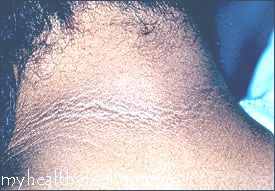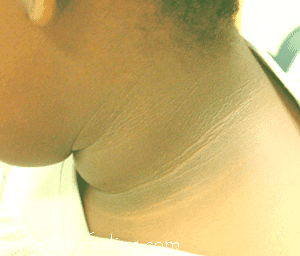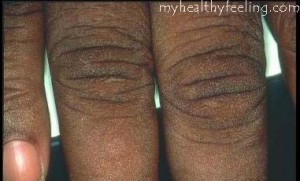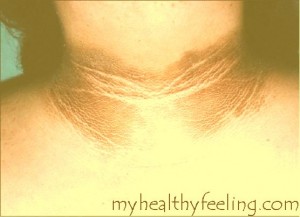What is Acanthosis Nigricans?
Acanthosis nigricans is a skin condition wherein there is excess darkening or hyper-pigmentation of the skin as well as other skin abnormalities such as excessive skin thickening. Acanthosis nigricans generally tends to occur in the creases or folds of the skin and affects areas such the back of the neck, the armpits and the groin.
Acanthosis nigricans is not exactly a skin disorder. It can be considered as a symptom of an underlying health condition or disease.
Acanthosis nigricans causes a lot of worry and distress among the patients, because of its abnormal appearance. There is no known cure for the condition, but on most occasions treatment of the underlying condition can lead to the disappearance of the skin irregularities.
Symptoms of Acanthosis Nigricans
Some of the signs and symptoms of acanthosis nigricans are listed below:
- Irregular patches of discolored, pigmented, velvety and thickened pattern of skin may appear on any region of the body, but most commonly occur on the creases of the skin in areas such as the armpits, the back of the neck and the groin. This is the most common symptom of acanthosis nigricans
- Multiple abnormal growths that look like fingers may be found on mucus membranes or skin surfaces
- Skin tags often appear in and around the affected regions
- On rare occasions the affected areas may result in itching
- The mucus membranes of the mouth, the nasal passages as well as the airways may be vulnerable to the formation of acanthosis nigricans lesions
- The malignant forms of acanthosis nigricans generally tend to have severe cases of lesions on the palms as well as the soles of the feet.
- Individuals who have malignant forms of acanthosis nigricans do not tend to be overweight, are middle-aged and are prone to the sudden and unexpected onset of lesions.
- Most of the skin changes that are associated with acanthosis nigricans progresses slowly over months and even years.
Types of Acanthosis Nigricans
The two main types of acanthosis nigricans are malignant and benign.
The malignant form of acanthosis nigricans is rare, whereas the benign form is more common. The benign type is often referred to as ‘pseudoacanthosis nigricans’. Based on their characteristics, there are seven different types of acanthosis nigricans. They are as follows:
- Acanthosis nigricans associated with obesity is the most common type of acanthosis nigricans. It tends to occur during adulthood but can also occur at any age. The obesity in such individuals is often the result of insulin resistance.
- Syndromic acanthosis nigricans is the type that is most often the result of an underlying syndrome within the affected individual such as Cushing’s syndrome, total lipodystrophy, hyperinsulinaemia or polycystic ovary syndrome.
- Benign acanthosis nigricans is most common in individuals who are dark skinned, particularly those of African American descent. It results in the formation of velvety, thick lesions that are most prevalent on the palms of the hands and the soles of the feet. Such individuals are otherwise devoid of illnesses. This type of acanthosis nigricans is often known as acral acanthotic anomaly
- Drug-induced acanthosis nigricans is rare and usually results from the intake of medications such as hormone treatments, nicotinic acid, systemic corticosteroids and insulin.
- Hereditary benign acanthosis nigricans may result in the manifestation of lesions at all ages including toddlerhood, adolescence and adulthood. This type of acanthosis nigricans is inherited as an autosomal dominant trait
- Malignant acanthosis nigricans is generally associated with an internal malignant condition, the most common malignancy being tumor of the gut such as stomach cancer. In most cases, this type of acanthosis nigricans results in the formation of lesions in the oral cavity as well the lips and the tongue.
- Mixed-type acanthosis nigricans is the type wherein one type of acanthosis nigricans leads to the development of another type. For example, obesity-associated acanthosis nigricans can lead to a malignant type of acanthosis nigricans.
Acanthosis Nigricans Causes
- Research studies have indicated that acanthosis nigricans is associated with elevated levels of insulin, that are usually triggered by underlying conditions such as being obese or the presence of type 2 diabetes.
- The additional insulin tends to offset abnormal activity on the skin cells that leads to the development of changes in the skin.
- Certain types of acanthosis nigricans are inherited and thus have a genetic basis.
- Some kinds of medications such as a large dosage of niacin or the use of oral contraceptives can lead to the condition
- Other conditions such as the presence of tumors, hormonal abnormalities as well as endocrine problems can cause acanthosis nigricans.
- Individuals who are dark skinned are more at risk to develop the condition than others.
Treatment of Acanthosis Nigricans
- Acanthosis nigricans has no exact treatment methods. The treatment of the underlying medical conditions is usually the best way to treat the skin changes associated with acanthosis nigricans.
Some treatment methods are:
- Exercise and dietary changes to lose the excess weight associated with obesity.
- Oral drugs such as isotretinoin
- A dermatologist may prescribe lotions or creams that contain modified vitamin A in order to lighten the affected regions
- Fish oil supplements
- Laser therapy to help alleviate the increased thickness of the affected areas
- The thick lesions generally tend to emit a bad odor. The use of topical antibiotics as well as antibacterial soaps can be helpful to prevent this sign of acanthosis nigricans.
Acanthosis Nigricans Pictures



